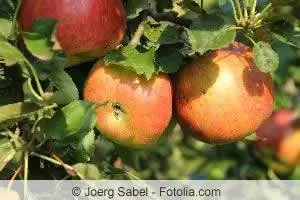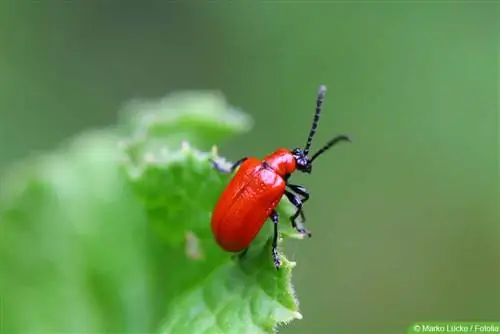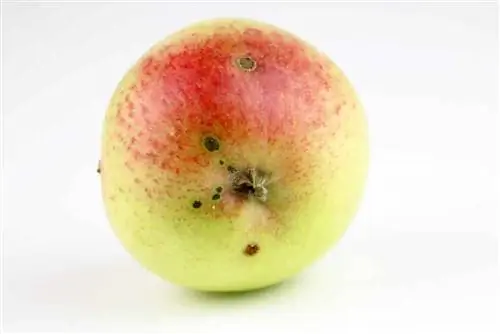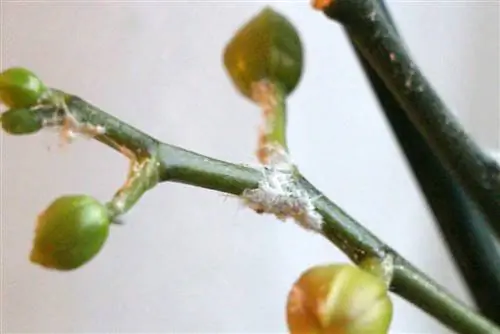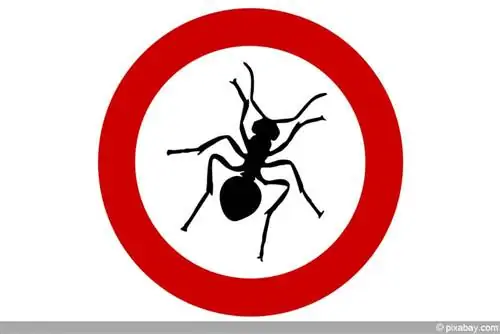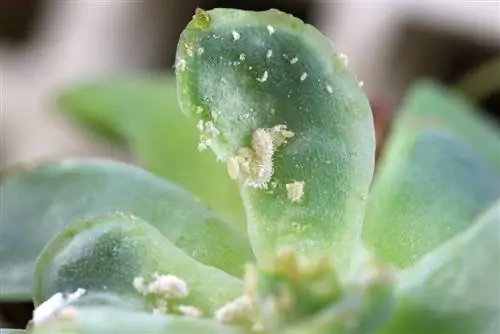- Author admin [email protected].
- Public 2023-12-17 03:39.
- Last modified 2025-01-24 12:45.
The blood louse, a subspecies of aphids, is not native to Europe. It only came from North America to Central Europe at the end of the 18th century. Its name comes from the fact that it releases a red liquid when crushed. It prefers to attack apple trees and is therefore a widespread pest in apple orchards and gardens. There are a variety of methods to combat blood louse and their breeding populations. We give you an overview of the control measures as well as tips and tricks for application.
Behavior and characteristics of blood lice
The blood louse (Latin: Eriosoma lanigerum) overwinters on the root neck of apple trees as gray-brown larvae and likes to appear in the garden in locations protected from the wind. It nests primarily in wounds and cracks in the bark. However, it can also survive the winter in the ground. Some specimens even sit at a depth of 50 cm. In spring the bloodlice migrate to the tops of apple trees. There they form a white waxy layer around their bodies, which protects them from unpleasant weather conditions and even from pesticides. As soon as the winged offspring develop in summer, they quickly attack the surrounding trees and trees. Espalier fruit can also be affected, as can rowan trees, cotoneasters and ornamental quinces.
Characteristic damage pattern
In addition to the white, woolly populations, the cancerous growths on the apple trees, especially on the young shoots, are very characteristic of bloodlice infestations. These growths are called blood louse cancer. They are formed as a reaction of the fruit trees to the sucking activity of the blood lice, which can also be carriers of viral diseases, such as apple addiction. In addition, the trees are contaminated by the sticky excretions of the bloodlice.
Mechanical means
The blood louse colonies can be brushed off or rinsed with water. It is best to rinse the blood lice off with a strong stream of water. Large canker sores in the wood are cut out and sealed with tree wax.
Biological control
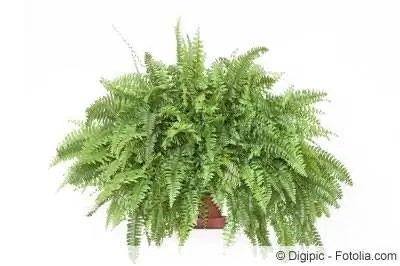
Basically, bloodlice are difficult to combat with pesticides because they cannot or can hardly penetrate the white wax cotton. However, persistence with biological means pays off here.
Extract and tea of bracken fern or worm fern
Worm and bracken contain small amounts of some toxic substances such as phloroglucin derivatives, certain bitter substances, tannins and oils. At normal doses, the poisons are not dangerous for pets or people.
Fern Extract
Crush 10 g of leaves and put them in a bottle with 1 l of rainwater. This is corked and has to steep for three days. The extract is then filtered off and sprayed undiluted onto the brushed areas of blood lice. Then repeat the procedure every three days.
Tip:
To improve the effect of the extract, you can add crushed green walnut shells or horse chestnuts to the base. The fern extract spray can also be used preventatively in winter.
Fernwort tea:
To make fern tea, 1 kg of fresh or 150 g of dried fern leaves are left to stand with 1 liter of water for a day and then boiled for 30 minutes. After it has cooled, the tea is diluted 1:10 and sprayed or brushed onto blood louse nests. The brushed blood louse nests must be really dripping wet.
Nasturtium tea:
Pour 10 liters of boiling water over 2 kg of fresh nasturtium herb and let it steep, covered, for about 15 minutes. After cooling, filter and spray undiluted on the bloodlice and canker sores on the apple trees.
Nasturtium press juice:
Squeeze or squeeze fresh nasturtium herb. The resulting press juice is brushed onto the blood lice and canker sores.
Neem oil blend
If you have a very severe bloodlice infestation, you can also try neem oil, which is non-toxic to mammals and humans. The ingredients in neem oil prevent sucking insects from breeding, while beneficial insects remain unharmed. The neem oil is mixed with water and an emulsifier called Rimulgan. This is a natural emulsifier made from neem oil. Rimulgan and neem oil are commercially available.
- 1 ml Rimulgan
- 1 ml neem oil
- 500 ml water
- put everything in an atomizer
- shake well
- Brush or spray the solution onto the lice
Bitterwood spray broth (Quassia amara)
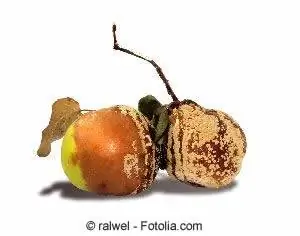
Wood chips from the Brazilian quassia tree can also be used against sucking insect pests such as blood louse. To make a spray mixture, 150 to 250 g of bitterwood chips (commercially available) are mixed with 2 l of water and left to stand for 24 hours. The solution is then boiled for half an hour. This broth is diluted with approx. 10 to 20 liters of water. It lasts about 4 to 6 months. The wood chips themselves can be dried again after cooking. This means they can be used for two to three additional applications. According to experts, Quassia is harmless to bees and also has no side effects for predatory mites, ladybirds and lacewings. Spray the affected areas on the apple tree sparingly. As soon as a coating forms after two to three days, clean the branches with clear water or horsetail broth.
Tip:
Always remember to brush the blood louse colonies off the affected branches before spraying. And always use broths, extracts and teas carefully. No beneficial insects should be affected.
Use beneficial insects against the blood louse
The best prerequisites for keeping bloodlice populations to a low level is an intact beneficial fauna, although this is not always the case. That's why you should try to attract the bloodlice's predators, especially the bloodlice wasp, as well as earwigs, ladybirds and larvae of lacewings and hoverflies, into your garden.
Blood louse wasp:
The blood louse wasp (Aphelinus mali) is one of the so-called parasitic wasps. It was introduced to Europe from North America at the beginning of the 20th century to control the blood louse. It is still used today as a predator of bloodlice in organic fruit production. It is very small and only 0.7 to 1 mm in size. It has a black body and yellow hind legs and antennae. This tiny wasp lives near blood louse colonies. The females lay their eggs inside the bloodlice so that the larvae can feed on the lice and develop inside them until they emerge as an adult wasp. All stages of the blood lice are affected. The infected lice can be recognized by their black body, which is no longer covered with wax wool.
Settle beneficial insects
To introduce more beneficial insects such as ladybirds, lacewings and earwigs, you can build protective insect hotels, pile up dead wood or hedge and tree cuttings in certain places in your garden and leave a few withered stems of perennials and summer flowers in the fall. You can also support the settlement of the beneficial insects with a piece of hardwood into which you drill holes of different lengths. Hang the wood in a warm and protected place in your garden. Small ponds and natural ponds also bring biodiversity and a natural balance to your garden.
Prevention and control
As a preventative measure, you can attach glue rings to the trunk of the trees to stop the lice from migrating from the ground up into the crowns in spring.
Check the affected branches regularly and spray or brush as needed.
Conclusion
Getting bloodlice out of apple trees is not that easy, even though there are many ways to do it. Their woolly wax layer protects them. However, you can stop them with continuous brushing and spraying with organic plant broths and teas. And the beneficial insects will help you if you leave them in your garden or lure them in.

